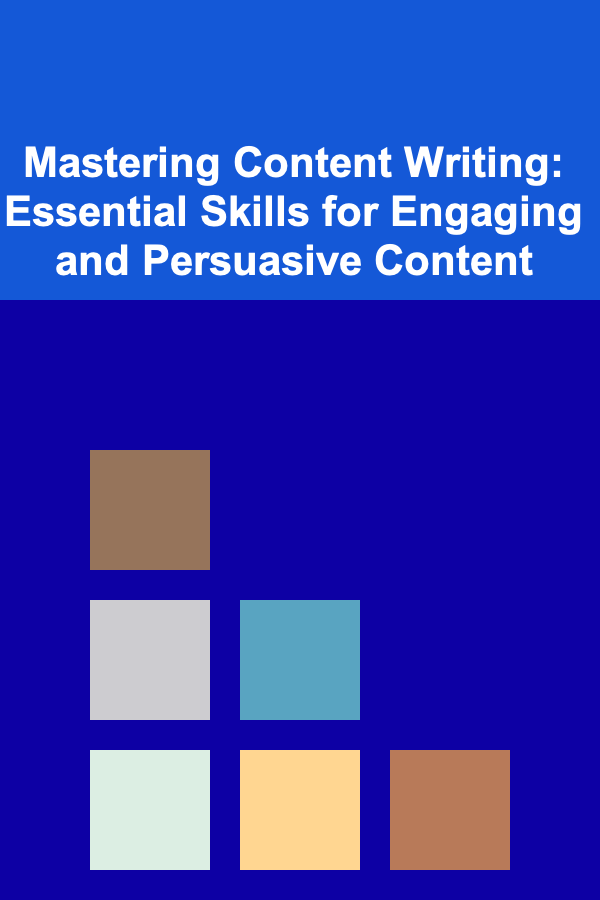
Mastering Content Writing: Essential Skills for Engaging and Persuasive Content
ebook include PDF & Audio bundle (Micro Guide)
$12.99$5.99
Limited Time Offer! Order within the next:

Content writing is more than just crafting sentences; it's about creating compelling narratives that captivate readers, inform them, and drive action. Whether you're writing for blogs, social media, or marketing campaigns, the ability to produce engaging and persuasive content is an invaluable skill. In this guide, we'll explore the essential skills needed to master content writing and deliver content that resonates with audiences.
Understanding Your Audience
One of the most important skills in content writing is the ability to understand and connect with your audience. The more you know about your readers---their needs, pain points, interests, and preferences---the better you can tailor your content to engage them.
Why Audience Understanding Matters
Writing without an audience in mind is like speaking into a void. Without understanding who you're writing for, your content will lack relevance and impact. When you know your audience, you can adjust your tone, style, and message to align with what they care about, making your content more engaging and persuasive.
Actionable Tips:
- Create Buyer Personas: Define who your audience is. Consider their age, gender, occupation, challenges, goals, and motivations.
- Conduct Surveys or Research: Regularly engage with your audience through surveys, social media polls, or comments to gain insights into their preferences and pain points.
- Use Analytics: Utilize tools like Google Analytics, social media insights, and audience feedback to track which content resonates the most and adjust accordingly.
Crafting Attention-Grabbing Headlines
The headline is the first thing readers will see, and it's the deciding factor in whether they'll click to read more. A great headline grabs attention, sparks curiosity, and encourages readers to dive into the content.
Why Headlines Are Crucial
In today's digital world, people are bombarded with information, and their attention span is shorter than ever. A well-crafted headline stands out in a sea of content and compels the reader to click and read further. A strong headline also sets the tone for the rest of the content.
Actionable Tips:
- Be Specific and Clear: Instead of vague titles, give readers an idea of what they'll get from the article. For instance, "How to Boost Your Social Media Engagement" is more specific than just "Social Media Tips."
- Use Numbers and Lists: Headlines that include numbers often perform better because they promise easy-to-digest, actionable information. For example, "7 Tips to Write Compelling Content."
- Incorporate Power Words: Use emotionally charged words like "ultimate," "proven," "easy," or "secret" to make the headline more enticing.
- Keep It Short and Punchy: Aim for headlines that are clear, concise, and easily scannable. The ideal headline length is typically between 6 to 12 words.
Writing Compelling Introductions
The introduction is your chance to hook the reader and convince them that your content is worth their time. A compelling introduction grabs attention, sets expectations, and smoothly leads into the rest of the article.
Why Introductions Matter
An engaging introduction builds curiosity and establishes the relevance of your content. It's the gateway that encourages readers to continue reading and invest in what you have to say.
Actionable Tips:
- Start with a Hook: Begin your introduction with something that grabs attention. This could be a thought-provoking question, a surprising fact, or a bold statement.
- Address Pain Points: Identify the problem your audience faces and hint at how your content will help solve it.
- Keep It Short and Focused: Avoid long-winded intros. Get straight to the point and let the reader know why they should care.
Mastering the Art of Storytelling
Storytelling is one of the most powerful tools in content writing. People are naturally drawn to stories, and a well-told story can make your content more memorable, relatable, and impactful.
Why Storytelling Works
A good story evokes emotions, creates connections, and helps the reader visualize the content in a more personal and engaging way. When you weave a narrative into your writing, you transform dry information into something that resonates with readers, making it easier for them to connect with the message.
Actionable Tips:
- Use Real-life Examples: Illustrate your points with real-life anecdotes, case studies, or testimonials to make the content feel more tangible and authentic.
- Follow a Narrative Structure: Use a clear beginning, middle, and end in your content. Introduce a problem, build tension, and provide a solution.
- Show, Don't Tell: Instead of simply stating facts, use descriptive language and vivid imagery to make the content more engaging.
Writing with Clarity and Precision
Clear and precise writing is essential for keeping readers engaged. If your content is difficult to follow or full of jargon, readers will quickly lose interest and move on to something else.
Why Clarity Matters
Complex, convoluted writing can confuse your readers, causing them to disengage. On the other hand, clear writing ensures that your message is easily understood, which keeps readers interested and coming back for more.
Actionable Tips:
- Use Simple Language: Avoid using unnecessary jargon or overly complex sentences. Write in a way that is easy for your audience to understand.
- Be Concise: Eliminate unnecessary words and get to the point quickly. Each sentence should add value to the content.
- Avoid Repetition: Repeating the same point in different ways can bore your readers. Stick to the essentials to maintain interest.
Building Persuasive and Actionable Content
The ultimate goal of content writing is often to persuade the reader to take action---whether it's making a purchase, signing up for a newsletter, or engaging with your brand. Persuasive writing uses specific techniques to guide readers toward making that decision.
Why Persuasion is Key
Persuasion is about influencing the reader's emotions and logic in such a way that they feel compelled to act. In many cases, content writers must create an emotional connection with the audience while simultaneously presenting logical arguments to back up their message.
Actionable Tips:
- Use Social Proof: Incorporate testimonials, reviews, or case studies to show that others trust and value what you're offering.
- Focus on Benefits, Not Features: Instead of simply listing the features of a product or service, explain how those features will benefit the reader.
- Create a Sense of Urgency: Use time-sensitive language like "limited offer" or "act now" to motivate readers to take action sooner rather than later.
Optimizing Content for SEO
SEO (Search Engine Optimization) is a critical skill for content writers. The more visible your content is in search engines, the more likely it is that readers will find it. SEO-optimized content helps improve search rankings and drives organic traffic.
Why SEO Matters
SEO is about ensuring that your content is discoverable by search engines, making it easier for potential readers to find your work. By strategically using keywords and optimizing your content, you can increase its visibility, reach, and effectiveness.
Actionable Tips:
- Research Keywords: Use tools like Google Keyword Planner or Ubersuggest to identify high-ranking keywords in your niche.
- Use Keywords Naturally: Incorporate your target keywords in the headline, introduction, body, and conclusion, but avoid keyword stuffing.
- Optimize Meta Descriptions: Write compelling meta descriptions that include keywords and encourage clicks from search results.
- Use Internal and External Links: Link to relevant internal pages or external resources to improve your content's authority and SEO ranking.
Editing and Proofreading
Good writing doesn't end with the first draft. Editing and proofreading are crucial steps in the content creation process that can dramatically improve the quality and professionalism of your work.
Why Editing and Proofreading Matter
Even the best writers make mistakes. Editing and proofreading help you catch errors, improve clarity, and ensure that your content is polished and professional. This step is essential for ensuring your content reflects your brand and maintains your credibility.
Actionable Tips:
- Take a Break Before Editing: After finishing a draft, step away for a bit before revisiting it. This will give you a fresh perspective and help you catch mistakes.
- Read Aloud: Reading your content aloud helps you identify awkward phrasing and sentences that don't flow smoothly.
- Use Tools: Leverage tools like Grammarly or Hemingway Editor to catch spelling, grammar, and readability issues.
Conclusion
Mastering content writing is an ongoing process that requires a blend of creativity, strategy, and technical skill. By understanding your audience, crafting compelling headlines and introductions, leveraging storytelling, and refining your writing through editing, you can create content that not only engages but persuades.
To truly master content writing, you must continually practice, stay updated on trends, and refine your skills. Whether you're writing blog posts, social media content, or marketing materials, the ability to produce high-quality, engaging content is an invaluable skill that can open doors to new opportunities and help you build a strong connection with your audience.

Best Organization Tools for Mental Health and Self-care
Read More
How To Master Early Childhood Education Principles
Read More
How to Organize Your Technology: Gadgets, Cords, and Accessories
Read More
How to Tackle Pet Hair on Furniture and Fabrics
Read More
How to Understand Craft Beer Filtration and Clarity
Read More
Navigating Employment Law in Recruitment: A Comprehensive Guide
Read MoreOther Products

Best Organization Tools for Mental Health and Self-care
Read More
How To Master Early Childhood Education Principles
Read More
How to Organize Your Technology: Gadgets, Cords, and Accessories
Read More
How to Tackle Pet Hair on Furniture and Fabrics
Read More
How to Understand Craft Beer Filtration and Clarity
Read More